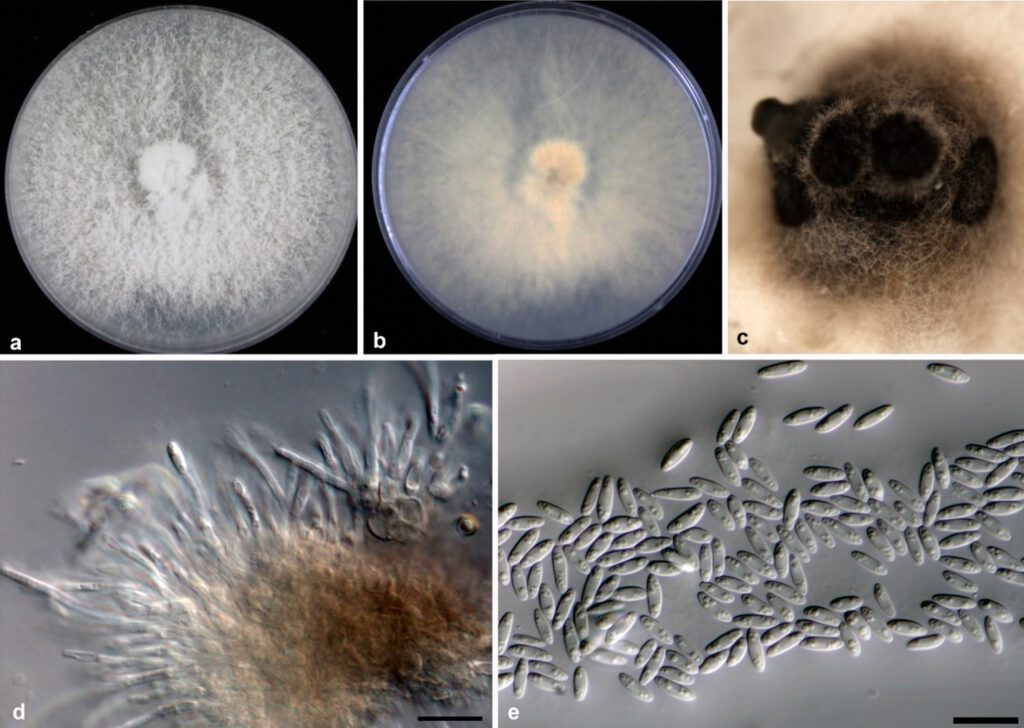Diaporthe viciae W. Zhao, Q. Ning, & J.Y. Yan, sp. nov.,
MycoBank number: MB 558423; Index Fungorum number: IF 558423; Facesoffungi number: FoF 10798;
Description
Asexual morph: Coelomycetous, Conidiomata visible as black aggregates up to 150–200 μm high, 150–250 μm diam., superficial, oval to round, black. Peridium thick, an inner layer composed of light brown to black textura angularis, outer layer composed of dark brown to black textura angularis. Conidiophores 15—32.5 μm long, cylindrical, aseptate, densely aggregated, apex. Conidiogenous cells phialidic, cylindrical, terminal, and lateral. Alpha conidia with 2–5 guttules per cell, 7—10×2—4 μm (x̅ =8.3×3.0 μm,n = 50), hyaline, fusiform or oval. Beta conidia not observed. Sexual morph: not observed.
Cultural characteristics – Colonies on PDA white (surface) and yellowish white (reverse), reaching the edge of the plate, with a dense mat of aerial mycelium, covering a 30 mm Petri dish in 5-7 days.
Material examined: China, Guangxi Province, Guilin City, from Vicia villosa stem, Zhao Wensheng and Zhang Guozhen, May 2018, (JZBH 320179 holotype), living culture = JZB 320179.
Distribution: China
Notes: Isolate (JZB 320179) was recovered from Vicia villosa stems from Guangxi Province. It fits the concept of Diaporthe. Multi-marker analysis for Diaporthe viciae using ITS, his, tub, cal, and tef-1 α markers produced a sister clade to Diaporthe podocarpi-macrophylli (LC 6155) with 85% ML support (Fig. 19). Comparison between the ex-type strain of D. podocarpi-macrophylli and D. viciae revealed different conidiomatal and conidial characters. Diaporthe podocarpi-macrophylli produced relatively larger conidiomata than D. viciae (222–699 μm diam. vs 150–250 μm diam.) and smaller alpha conidia (3.5–8.5 × 1–3 μm vs 7—10×2—4 μm). Diaporthe is considered as one of the most species-rich genera in Diaporthaceae, and most of the species share similar morphological characters. Even though species of Diaporthe have a wide host range in terrestrial habitats, we could not find any Diaporthe species that have been associated with Vicia villosa (Farr and Rossman 2022). There were three records in Farr and Rossman database where Diaporthe has been recorded from other Vicia spp. (V. fabae and V. sativa) in Australia and Italy. Therefore, from this study, we provide the first host association of Diaporthe species on Vicia villosa.

Fig. x. Diaporthe viciae (JZBH 320179, holotype) a. Upper view of the colony on PDA, b. Back view of the colony on PDA, c Conidiamata on PDA, d Conidia attached to the conidiophores, e Conidia. Scale bars: d, e= 10 µm.
